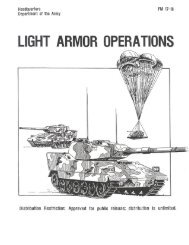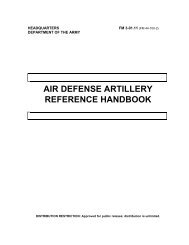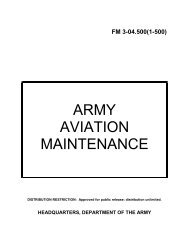fm 44-100 us army air and missile defense operations
fm 44-100 us army air and missile defense operations
fm 44-100 us army air and missile defense operations
You also want an ePaper? Increase the reach of your titles
YUMPU automatically turns print PDFs into web optimized ePapers that Google loves.
FM <strong>44</strong>-<strong>100</strong><br />
HELICOPTERS<br />
2-6<br />
2-12. UAV payloads consist of daylight television <strong>and</strong> IR video cameras, <strong>and</strong><br />
film cameras (for reconnaissance missions). Other major payload categories<br />
include electronic warfare (EW), electronic intelligence, radar, <strong>and</strong> attack<br />
warheads. Several nations are developing <strong>and</strong> fielding anti-radiation homing<br />
UAV with the primary mission of attacking battlefield RF emitters (radar,<br />
communications). These platforms have a variety of launch options <strong>and</strong> are<br />
<strong>us</strong>ually fire-<strong>and</strong>-forget systems. Other attack UAV systems employ terminal<br />
guidance to kill tanks or fighting vehicles.<br />
2-13. Current projections indicate more than 50 developer countries <strong>and</strong> 75<br />
<strong>us</strong>er countries of UAVs by 2005. In addition to information gathering (still<br />
the dominant function), UAV roles will include electronic combat, decoy,<br />
ground attack, <strong>and</strong> suppression of enemy <strong>air</strong> <strong>defense</strong> (SEAD). A significant<br />
new capability involves the direct linkage of a reconnaissance UAV to an<br />
artillery unit’s fire direction center. This linkage provides near real time<br />
information to ground comm<strong>and</strong>ers, followed by immediate fire <strong>and</strong> damage<br />
assessment. UAVs are also good c<strong>and</strong>idates for stealth technology <strong>and</strong> spinoff<br />
technologies from CM developmental programs. Figure 2-5 ill<strong>us</strong>trates<br />
UAV characteristics.<br />
Targets<br />
• Assembly/logistical areas<br />
• Comm<strong>and</strong> <strong>and</strong> control centers (seeing/jamming)<br />
• Troop movements (seeing)<br />
• Sensor nodes (jamming)<br />
• Armored formations/systems (attacking)<br />
Current Capabilities<br />
• RSTA, EW, attack missions<br />
• Range to 1900 Km<br />
• Altitude 300 m to 17+ Km<br />
• St<strong>and</strong> off/detect from 25 Km<br />
• Payloads: daylight TV, cameras,<br />
HE warheads, laser spotters<br />
Future Trends<br />
• Added missions: decoy,SEAD,<br />
electronic combat<br />
• St<strong>and</strong>off range 50+ Km<br />
• Detection to 70 Km<br />
• All weather day/night capability<br />
Figure 2-5. Characteristics of Unmanned Aerial Vehicles<br />
2-14. Most countries maintain helicopters to support military <strong>operations</strong>. The<br />
majority of the helicopters are utility systems that are, or can be, armed to<br />
perform a variety of roles, th<strong>us</strong> offering an inexpensive <strong>and</strong> effective<br />
substitute to the more expensive attack helicopter. The versatility <strong>and</strong><br />
survivability of helicopters make them ideal for <strong>us</strong>e in most combat areas.<br />
What makes helicopters threatening? Threat ground-force comm<strong>and</strong>ers<br />
primarily rely on helicopters to fulfill direct <strong>air</strong> support requirements.<br />
Helicopters can perform a variety of missions. Hovering <strong>and</strong> low-flying<br />
helicopters, taking full advantage of terrain masking, are difficult to acquire











